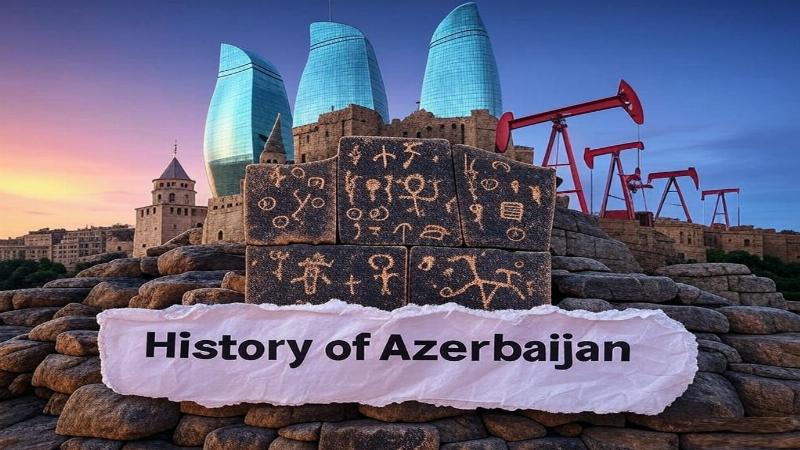Place for ads

Azerbaijan, a nation at the crossroads of Eastern Europe and Western Asia, is a land where ancient heritage meets modern ambition. Nestled between the Caspian Sea and the Caucasus Mountains, its 86,600 square kilometers have witnessed empires, trade routes, and revolutions. Known today for its oil wealth and vibrant capital, Baku, Azerbaijan’s history stretches back millennia, shaped by its strategic position and resilient people. In this article, we’ll journey through Azerbaijan’s past, from its earliest settlers to its contemporary identity, uncovering the forces that have defined this dynamic nation.
Azerbaijan’s story begins in the Paleolithic era, with evidence of human activity dating to around 1.5 million years ago. The Azokh Cave in Nagorno-Karabakh has yielded Neanderthal tools and fossils, while petroglyphs at Gobustan—dated to 10,000 BCE—depict hunters, dancers, and boats, hinting at a sophisticated prehistoric culture. These UNESCO-listed rock carvings show a people tied to the Caspian’s shores.
By the Bronze Age (circa 3000 BCE), the Kura-Araxes culture emerged, known for its pottery and metalwork. Settlements along the Kura River traded with Mesopotamia, laying early roots for Azerbaijan’s role as a cultural bridge. The Iron Age brought tribal societies, setting the stage for one of
Place for ads
By the 4th century BCE, the region of modern Azerbaijan formed part of Caucasian Albania (not to be confused with Balkan Albania). This kingdom, centered north of the Kura River, blended local tribes with influences from Persia and Greece. Its capital, Qabala, thrived as a trade hub, while Zoroastrianism shaped its early faith.
Rome and Parthia vied for control, but Albania retained autonomy until the Sassanid Persians annexed it in the 3rd century CE. In 313 CE, King Urnayr adopted Christianity, aligning with Armenia—making Caucasian Albania one of the earliest Christian states. The 7th-century Arab conquest brought Islam, reshaping its culture and leaving ruins like those at Barda.
The 9th century saw the rise of Islamic dynasties like the Sajids and Shirvanshahs. The Shirvanshah state, based in Shamakhi, flourished along the Silk Road, its palaces and mausoleums reflecting Persian splendor. By the 11th century, Seljuk Turks swept in, bringing Oghuz tribes whose descendants became the Azeri people, fusing Turkic and Caucasian roots.
Mongol invasions in the 13th century devastated the region, but recovery came under the Safavids of Persia in the 16th century. Shah Ismail I made Shia Islam the state religion, a legacy that endures in Azerbaijan today. Cities like Baku grew as Caspian ports, trading oil and saffron, while the khanates—small feudal states—emerged in the 18th century.
The 19th century shifted Azerbaijan’s fate. After the Russo-Persian Wars (1804–1813 and 1826–1828), treaties of Gulistan and Turkmenchay ceded northern Azerbaijan to Russia, splitting it from Persian-held south. Baku became a Russian hub, its oil fields sparking an industrial boom by the 1870s—drawing Nobel and Rothschild investments.
Russian rule modernized infrastructure but stifled autonomy. Intellectuals like Mirza Fatali Akhundov fostered a national awakening, blending secularism with Persian and Turkic traditions. The 1905 Russian Revolution stirred unrest, setting the stage for a brief taste of independence.
After Russia’s 1917 collapse, the Azerbaijan Democratic Republic (ADR) emerged on May 28, 1918—the first secular Muslim democracy. Led by the Musavat Party, it granted women suffrage before many Western nations and established Baku as its capital. Yet, it faced threats—Bolsheviks, Armenians, and British troops vied for control.
The ADR lasted just 23 months. In April 1920, the Soviet Red Army invaded, toppling the republic and creating the Azerbaijan SSR. This fleeting independence left a legacy of national pride, its tricolor flag revived in 1991.
Under Soviet rule (1920–1991), Azerbaijan transformed. Oil fueled Stalin’s Five-Year Plans—by World War II, Baku supplied 80% of Soviet petroleum. Factories and schools sprang up, while the Azeri alphabet shifted from Arabic to Latin, then Cyrillic, reflecting Moscow’s grip.
Repression marked the era. The 1930s purges killed thousands, including poets like Huseyn Javid. World War II saw 600,000 Azeris fight, with 300,000 dying. Post-war, oil declined, but culture thrived—composers like Uzeyir Hajibeyli blended folk and classical music, preserving identity under Soviet rule.
The Soviet collapse in 1991 brought independence on October 18. Ayaz Mutalibov became president, but chaos loomed. The Nagorno-Karabakh conflict with Armenia erupted in 1988, escalating into war by 1991. Armenian forces, backed by Russia, seized the enclave and surrounding areas, displacing 600,000 Azeris by the 1994 ceasefire.
Political turmoil followed. Mutalibov fell in 1992, replaced by Abulfaz Elchibey, then Heydar Aliyev in 1993. Aliyev, a former Soviet official, stabilized Azerbaijan, signing the “Contract of the Century” in 1994 to exploit Caspian oil with Western firms, sparking an economic boom.
Heydar Aliyev ruled until 2003, succeeded by his son Ilham. Oil and gas—piped via the Baku-Tbilisi-Ceyhan pipeline—drove growth, turning Baku into a gleaming metropolis with landmarks like the Flame Towers. The 2011 Eurovision win and 2015 European Games showcased Azerbaijan globally.
The 2020 Nagorno-Karabakh War shifted fortunes. Azerbaijan, aided by Turkish drones, recaptured much of the lost territory, ending with a Russia-brokered truce. Today, 10 million Azeris navigate prosperity and challenges—authoritarianism, corruption, and regional tensions linger.
Contemporary Azerbaijan balances tradition and modernity. Baku’s Old City, a UNESCO site, contrasts with its skyscrapers, while rural villages preserve carpet-weaving and tea culture. Oil wealth funds education and infrastructure, but inequality and press freedom issues persist. The diaspora—millions strong—ties Azerbaijan to the world.
Azerbaijan’s history is a tale of endurance at civilization’s edge. From Caucasian Albania to Soviet rule, war to wealth, it’s a nation shaped by its land and people. As Azerbaijan strides forward, its past—etched in rock, oil, and fire—fuels a future of promise and pride.
Place for ads